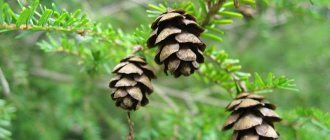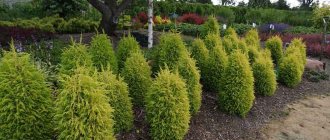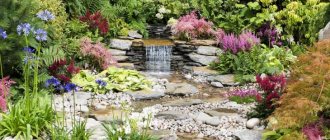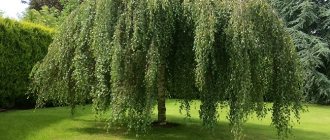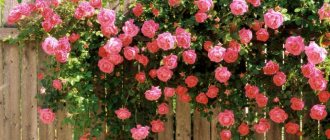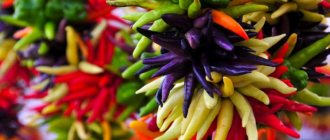A corner of paradise, where everything around is fragrant and pleasing to the eye... Is this how you want your garden to look in moments of relaxation?
It’s a completely understandable desire, and we’ll tell you how to make it come true. How to turn your plot into a fragrant paradise?
A breath of fresh air is our first impression after a flight when we arrive at a distant resort. At these moments we feel the changes especially acutely - the south greets us with aromas. Having reached the final point of the journey, we see that it could not be otherwise: not only the flowers are fragrant, but also the trees and shrubs.
Sources of pleasant odors do not always reveal themselves at first sight. Sometimes you have to come close to see small and not very interesting flowers or be surprised to discover that it’s not the flowers that smell, but the leaves or pine needles. Northern nature is poorer in aromas, but in the garden we can collect them into a “bouquet” sufficient to turn a summer cottage into a fragrant paradise.
What is needed for this? It would seem that everything is very simple: plant more fragrant plants. But remember: pinpoint “inclusions” of aromas will dissolve in space, so it makes sense to “increase the concentration.” It is clear that the contribution from a hedge of lilac or jasmine is incomparably greater than from a separate bush, and the aroma from a wide strip of snowdrops and corydalis planted under it spreads further than from a small curtain in a flowerbed.
Important : each fragrant plant has its own “critical mass” at which it is able to make itself known from a distance. It is this factor that is worth focusing on.
Crown jasmine or garden jasmine (Philadelphus coronarius) is an excellent choice for a fragrant hedge.
There is one more important nuance: most often, we are primarily attracted by the beauty of plants, and not by their aroma. Therefore, when creating a fragrant corner, we are faced with a contradiction, discovering that our favorite plants sometimes try to slightly deceive us, not meeting our expectations. But this problem can be corrected, because the same garden crop is often represented by both fragrant and odorless varieties. On the one hand, peonies, lilies and roses also have varieties without fragrance, which in our minds “should” be fragrant.
On the other hand, pleasant surprises also happen where we don’t expect them. For example, in a sea of scentless tulips, there are masterpieces not only in beauty, but also in aroma.
Advice: without giving up your favorite plants, find among them varieties that, by more fully affecting the senses, give rise to more pleasant emotions. Among the beauties of lilies (on the left), the most fragrant are oriental hybrids. It is better to buy tobacco and heliotrope (on the right) as seedlings, then you definitely can’t go wrong with the choice of variety
Night violet
Two-horned matthiola
Night violet or two-horned matthiola is an outwardly inconspicuous flower that gardeners may not like at first. But its strength is not in its beauty, but in the incredible sweet smell that spreads around the garden in the evening. The incredible scent of night violet lasts until the morning. This flower, which smells pleasantly of honey, will delight the eye throughout the summer. This unpretentious plant is not even afraid of the first frost.
It is recommended to sow two-horned matthiola directly into the soil in the spring. Night violet feels great in sunny areas, but can also develop well in shaded areas.
Peony
Many varieties of peonies are especially attractive and have a delicate scent. Their flowers emit the most aroma in the morning and last until noon. At this time it can be felt from afar.
Related article:
Marigolds - beneficial properties, planting and care
The culture also prefers sunny places and regular but moderate watering. Otherwise, peonies are unpretentious and can grow in one place for a long time.
Gray-haired matthiola
Gray Levkoy or Gray Mattiola
These fragrant flowers for the flowerbed are also called gray Levkoy. The plant has a pleasant aroma of honey, as well as double flowers that bloom in the shape of a hat. The height of the crop is up to 80 cm, there are also dwarf varieties - their height is no more than 20 cm. The flowers can be either regular or double. Flowering lasts for a month. The plant is planted only through seedlings, this allows you to get beautiful seedlings and flowers.
Fragrant blooming perennials in the garden
Perennial flowering plants with a pleasant aroma are good because after planting in the garden for several years they will delight the owner and his guests not only with the brightness of the flowers, but also with their aroma. Such plants include:
- peony
- alyssum
- reddish clover
- lily
- honeysuckle honeysuckle
- lilies of the valley
- chrysanthemums
- lush carnation
Alyssum or alyssum is a garden flower from the Brassica family, has many decorative varieties, most often low-growing or ground cover, from 10 to 30 cm in height, shoots branch well, flowers are small, collected in inflorescences - umbrellas, leaves are medium-sized, grayish-green, flower color white, light yellow.
The plant is unpretentious, grown from seeds by sowing before winter or spring, attracts flower lovers with a well-defined smell of honey, is suitable for decorating garden paths, flower beds, and is used as a ground cover plant that covers the ground with a snow-white fragrant carpet.
Red or reddish clover is a plant from the Legume family, the shape of the inflorescence bears little resemblance to pink clover or meadow clover, the inflorescences are large, elongated - ovoid, up to 10 cm long, collected from small narrow flowers, flowering time is June - September, have a pleasant smell, a bit like the smell of roses or wild rose hips.
Can be grown in partial shade, propagated by seeds or dividing the bush, suitable for corners of the garden decorated in a natural style. Peonies are perennial rhizomatous plants, the above-ground part dies off annually, and in the spring the growth of new shoots begins, propagates by roots, is planted before winter, the plant has many varieties, the flowers are large, fragrant, the smell is pleasant, sweet, the flowers are almost always single, they can be double, simple , semi-double, flowering time from late May - June.
Fragrant flowers for the garden on video:
Lush carnation is a perennial frost-resistant plant, has creeping rhizomes, thin long stems, large fragrant pink or lilac flowers, unpretentious when grown in the garden, can decorate rocky gardens and hills, has several varieties.
Fragrant tobacco
Fragrant tobacco
Another fragrant flower for the garden is fragrant tobacco. They look great both in flower beds and in pots. These fragrant flowers for the balcony are annuals, distinguished by long stems, white buds, and bloom in the evening. There are also many compact varieties, the petals of which are painted in raspberry, red, pink, lemon-yellowish shades. But the most pronounced smell is only in flowers with white buds.
Tobacco is grown using seedlings, which guarantees early flowering of the crop. Flowers are afraid of frost, so it is better to leave planting tobacco until real warmth arrives. The culture prefers areas with a lot of sunlight. Sometimes the plant is saved until the next season; for this, it is dug up and planted in pots, placing it in the basement. When spring comes, the dug-out crop returns to its original place.
Garden plants with wonderful aroma
Although many plants emit a strong and enchanting scent when they bloom, only a very few species act as natural perfumes that can be perceived from a distance. It is worth paying attention to this property, because in a fragrant garden . It has long been known that the smell of flowers affects well-being and health.
A garden in which the amazing aromas of flowers and greenery mix together is a dream that can easily be realized. There is a certain group of plants that emit an intense aroma that captivates not only insects, but also people. It is worth using this and choosing fragrant plants, especially since such species are at the same time extremely attractive and easy to place in gardens of various types. The smell of flowers can also have a beneficial effect on health - it has an anti-stress effect and improves mood.
Fragrant plants - where to plant?
Obviously, it should be understood that not every plant emits such a strong odor to please the sense of smell while walking around a large area of the garden. Therefore, fragrant plants should be planted in certain places:
- near the house on the windows (then the aroma can be felt even while in the house);
- near benches and other architectural elements such as terraces or gazebos;
- on the balcony;
- in places where there is already an unpleasant odor, for example, near a composter;
- trees and shrubs can be used as barriers from busy roads. In addition to the pleasant smell, the below-mentioned species can additionally form a dense wall, limiting pollution and noise to some extent.
Sweet pea
Sweet Peas
You can get wonderful evening garden scents by planting sweet peas. More than 100 varieties of this crop are known, there are varieties with large and small flowers, they are distinguished by different shades of petals. The bright smell is most characteristic of early varieties.
This type of vine is perfectly fixed to various supports and pergolas, so it is actively used for vertical gardening. Low-growing representatives look great in hanging baskets or containers. Sweet peas do not like transplanting, so it is recommended to plant them immediately in warm soil.
Lilies
No less beautiful and fragrant representatives of the flower kingdom are lilies. Almost all of them have a rich aroma, but the Royal Lily variety is especially noteworthy. Its smell, similar to an elite women's perfume, can be felt within a radius of several meters.
The flowers themselves are very large (up to 25 cm in diameter), attractive in appearance and cover the peduncles abundantly. To maximize its beauty and aroma, lilies should be planted in open, well-lit, wind-protected areas with good drainage.
Mignonette
Mignonette
Another fragrant flower is mignonette. The most famous varieties are “Victoria”, “Mashet”, “Ruby”, “Goliath”. Color: red-green, yellowish, dark brown, light green. Mignonette is planted in late April or early May. How mignonette sprouts depends on soil moisture and weather conditions. The first shoots are observed after 1-2 weeks. The culture prefers free space, so it must be thinned out. To grow plants, choose areas that receive good sunlight.
Lavender
You can easily fill your garden with the aromas of the Mediterranean by filling your flower garden with lavender. You can enjoy the smell of this plant at any time of the day, but it reaches its maximum concentration at the moment when the sun begins to wander towards the horizon.
Lavender is often used for relaxation. Inhaling the essential oils of this plant is believed to stabilize heart rate and reduce blood pressure.
- Lavender in open ground - planting, care, propagation
Everything you wanted to know about growing lavender.
Iberis
Iberis
Iberis has a modest appearance, but has an incredible aroma. The flowering of the plant lasts for a month. The most famous variety is bitter iberis, which has white inflorescences. The umbrella type of plant is also popular; it has lilac-pink flowers. This variety is also actively used for growing on loggias and balconies.
Phloxes
Even less capricious and at the same time lushly blooming and very fragrant are phloxes. These bushy perennials have inflorescences of various colors and, with the right selection of varieties, can bloom in the area from late spring to late autumn.
The honey smell of phlox is most strongly felt on sunny days, and the more sunshine, the more pronounced the aroma. Therefore, they should be planted in the sun, or at least in partial shade.
Rose
The variety of varieties, colors, shades of aromas of this luxurious flower is simply amazing. Certain varieties of roses can have a pronounced musky aroma, honey, fruity, citrus, fresh herbaceous. It is difficult to imagine a garden of scents without roses, which with their long flowering can transform even the most modest summer cottage.
The most fragrant varieties are: "Shutter's Gold" (golden-yellow buds), "Tiffany" (pinkish-cream flowers), "Alexander Pushkin" (another name is "Prince Jardiniere", white rose with a soft pink center), "Mr. Lincoln", a flower of rich red color, with a strong aroma), "Chrysler Imperial", crimson buds), "Blue Perfume" Perfum", soft lilac rose), "Westerland", "Duftrausch", "Papa Meilland".
Features of growing eucharis (video)
Any parts of the following indoor ornamental crops have a pleasant, pronounced aroma:
- the coniferous plant Araucaria is often grown at home and is characterized by a pleasant coniferous smell, and is also capable of saturating the air with beneficial phytoncides;
- indoor mint or Plectranthus is highly valued by indoor gardeners due to its ease of care and decorative attractiveness of the foliage;
- The evergreen perennial Myrtle has leathery leaves and single or numerous white flowers, collected in short racemes.
When placing fragrant plants in the house, you need to remember that fragrant crops are not recommended to be grown in the bedroom and children's room.
Jasmine
Grows in warm climates. Jasmine is known all over the world; its white flowers smell delicate and sweet. Essential oils based on this plant are widely used in cosmetology and aromatherapy. And jasmine tea is even made from dried flowers. The peculiarity of the flower is that the root system of the plant is poisonous, and the buds smell much stronger than the flowers. And the aroma can only be felt after sunset. In the Moscow region, mock orange or garden jasmine are successfully grown.
Alyssum
Alyssum is a perennial or annual ground cover plant, the flowers of which appear in early summer and fade only in late autumn with the arrival of cold weather. All this time they exude a bright honey aroma with notes of meadow herbs.
Alyssum plantings are unpretentious and do not require special care. They grow very quickly, forming a beautiful carpet of predominantly pale lilac or soft pink color. They are usually used in combination with early flowering bulbs (narcissus, tulips) to fill empty areas after flowering has finished.
